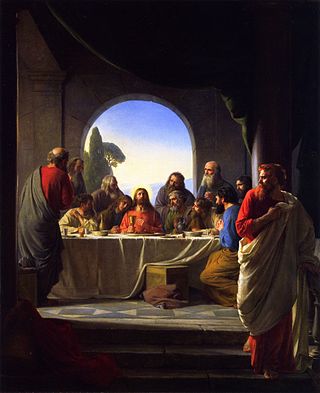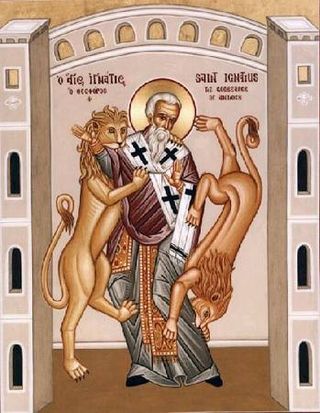Plot summary
Damien Har Veris — a priest skilled in resolving heretical disputes efficiently, although now spiritually exhausted — is sent by his alien archbishop as Knight Inquisitor to deal with a particular sect that has made a saint of Judas Iscariot.
The sect follows a religious text, The Way of Cross and Dragon, that radically revises the life of Iscariot and his place in Christianity. The text describes how, born of a prostitute, Iscariot mastered the dark arts to become a tamer of dragons and the ruler of a great empire. After torturing and maiming Christ, Iscariot repented and relinquished his empire to become the penitent Legs of Christ, the first and best-beloved of the Twelve Apostles. Returning from proselytizing to find Christ crucified, an enraged Iscariot then destroyed the perpetrating empire and strangled St. Peter for renouncing Christ, only to discover, too late, Christ's resurrection. Rejecting Judas' violence, Christ restored St. Peter to life and gave him the keys of the kingdom. St. Peter then suppressed the truth about Judas, vilifying his name and exploits. Seeking redemption for his wrath, Iscariot became the thousand-year-old Wandering Jew, before finally rejoining Christ in the Kingdom of God.
Perusing the materials of the sect, Har Veris finds himself enjoying the fanciful, creative but ultimately ridiculous narrative, finding it far more interesting than the more mundane heresies that have developed around power, money and doctrinal quibbles.
Arriving on the sect's distant planet on board his ship, the Truth of Christ, Har Veris confronts its heresiarch, Lukyan Judasson, creator of the Way of Cross and Dragon narrative, but finds that he is already expected. Questioning Judasson, Har Veris uncovers a conspiracy of nihilistic Liars, who see Truth as entropy and despair, and who wish to soften and color the ultimately meaningless lives of others by creating belief in carefully crafted Lies. In essence, they create faiths. They have perpetrated this Judas cult as well as others, and now want Har Veris to join them. Despite his own spiritual exhaustion, he realizes that, though he may be losing his faith, he has not lost his passion for truth. When he refuses to join the Liars, Judasson wishes to have him silenced, but his senior in the conspiracy, a misshapen psionic mutant, senses the impending Liar in Har Veris, and allows him to go.
Har Veris then uses political manipulation and the public's fear and distrust of psychic powers to turn the tide on the Judas cult, resolving yet another heresy with dispatch. When, much later, he fully acknowledges that he has lost his faith, his superior is indifferent: results are what is needed, and Har Veris is to continue in his role as inquisitor. The priest accepts this, realizing that the psychic was right: he is himself a consummate Liar, perpetuating a faith in which he no longer believes.
However, departing on his next Inquisition, he has named his new starship Dragon.
The Christian countercult movement or the Christian anti-cult movement is a social movement among certain Protestant evangelical and fundamentalist and other Christian ministries and individual activists who oppose religious sects that they consider cults.

Irenaeus was a Greek bishop noted for his role in guiding and expanding Christian communities in the southern regions of present-day France and, more widely, for the development of Christian theology by combating heterodox or Gnostic interpretations of Scripture as heresy and defining proto-orthodoxy. Originating from Smyrna, he had seen and heard the preaching of Polycarp, who in turn was said to have heard John the Evangelist, and thus was the last-known living connection with the Apostles.

Judas Iscariot was—according to Christianity's four canonical gospels—a disciple and one of the original Twelve Apostles of Jesus Christ. Judas betrayed Jesus to the Sanhedrin in the Garden of Gethsemane by kissing him on the cheek and addressing him as "master" to reveal his identity in the darkness to the crowd who had come to arrest him. Like Brutus, his name is often used synonymously with betrayal or treason.
Bogomilism was a Christian neo-Gnostic, dualist sect founded in the First Bulgarian Empire by the priest Bogomil during the reign of Tsar Peter I in the 10th century. It most probably arose in the region of Kutmichevitsa, today part of the region of Macedonia.

Peter of Verona, also known as Saint Peter Martyr and Saint Peter of Verona, was a 13th-century Italian Catholic priest. He was a Dominican friar and a celebrated preacher. He served as Inquisitor in Lombardy, was killed by an assassin, and was canonized as a Catholic saint 11 months after his death, making this the fastest canonization in history.
The Cainites or Cainians were a Gnostic and antinomian sect known to venerate Cain as the first victim of the Demiurge, the deity of the Old Testament, who was identified by many groups of Gnostics as evil. The sect was relatively small. They were mentioned by Tertullian and Irenaeus as existing in the eastern Roman Empire during the 2nd century. One of their purported religious texts was the Gospel of Judas.
Word of Faith is a movement within charismatic Christianity which teaches that those who believe in Jesus' death and resurrection have the right to physical health, that words have power, and that true faith is more than simply mental knowledge, but is deeply held belief that cannot be shaken. The movement was founded by the American Kenneth Hagin in the 1960s, and has its roots in the teachings of E. W. Kenyon.

The Gospel of Judas is a non-canonical Gnostic gospel. The content consists of conversations between Jesus and Judas Iscariot. Given that it includes late 2nd-century theology, it is widely thought to have been composed in the 2nd century by Gnostic Christians. The only copy of it known to exist is a Coptic language text that has been carbon dated to 280 AD, plus or minus 60 years. It has been suggested that the text derives from an earlier manuscript in the Greek language. An English translation was first published in early 2006 by the National Geographic Society.
Paulicianism was a Medieval Christian sect which originated in Armenia in the 7th century. Followers of the sect were called Paulicians and referred to themselves as Good Christians. Little is known about the Paulician faith and various influences have been suggested, including Gnosticism, Marcionism, Manichaeism and Adoptionism, with other scholars arguing that doctrinally the Paulicians were a largely conventional Christian reform movement unrelated to any of these currents.

The term proto-orthodox Christianity or proto-orthodoxy describes the early Christian movement that was the precursor of Christian orthodoxy. It was coined by Bentley Layton, but is often erroneously attributed to New Testament scholar Bart D. Ehrman. Ehrman argues that this group from the moment it became prominent by the end of the third century, "stifled its opposition, it claimed that its views had always been the majority position and that its rivals were, and always had been, 'heretics', who willfully 'chose' to reject the 'true belief'." In contrast, Larry W. Hurtado argues that proto-orthodox Christianity is rooted in first-century Christianity.

The Last Temptation of Christ is a 1988 epic religious drama film directed by Martin Scorsese. Written by Paul Schrader with uncredited rewrites from Scorsese and Jay Cocks, it is an adaptation of Nikos Kazantzakis' controversial 1955 novel of the same name. The film, starring Willem Dafoe, Harvey Keitel, Barbara Hershey, Andre Gregory, Harry Dean Stanton and David Bowie, was shot entirely in Morocco.
Heresy in Christianity denotes the formal denial or doubt of a core doctrine of the Christian faith as defined by one or more of the Christian churches.

The Milky Way is a 1969 comedy-drama film directed by Luis Buñuel. It stars Paul Frankeur, Laurent Terzieff, Denis Manuel, and Daniel Pilon, and features the likes of Alain Cuny, Michel Piccoli, and Delphine Seyrig in its ensemble cast. Buñuel later called The Milky Way the first in a trilogy about "the search for truth."
Nightflyers is a science fiction horror novella by American writer George R. R. Martin, released as a short novella in 1980 and as an expanded novella in 1981. A short story collection of the same name was released in 1985 that includes the expanded novella. In 1987, the short novella was adapted into a film by the same name. A 2018 television adaptation of the extended novella was developed; television presentation began on December 2, 2018, on the SyFy Channel.

Heresy is any belief or theory that is strongly at variance with established beliefs or customs, particularly the accepted beliefs or religious law of a religious organization. A heretic is a proponent of heresy.

Dark Heresy is a role-playing game published by Black Industries in 2008 that uses the Warhammer 40,000 Roleplay system. A second edition was published in 2014 under Fantasy Flight Games.

The following outline is provided as an overview of and topical guide to Christianity:

Traditionally in Christianity, orthodoxy and heresy have been viewed in relation to the "orthodoxy" as an authentic lineage of tradition. Other forms of Christianity were viewed as deviant streams of thought and therefore "heterodox", or heretical. This view was challenged by the publication of Walter Bauer's Rechtgläubigkeit und Ketzerei im ältesten Christentum in 1934. Bauer endeavored to rethink Early Christianity historically, independent from the views of the current church. He stated that the 2nd-century church was very diverse and included many "heretical" groups that had an equal claim to apostolic tradition. Bauer interpreted the struggle between the orthodox and heterodox to be the "mainstream" Church of Rome struggling to attain dominance. He presented Edessa and Egypt as places where the "orthodoxy" of Rome had little influence during the 2nd century. As he saw it, the theological thought of the "Orient" at the time would later be labeled "heresy". The response by modern scholars has been mixed. Some scholars clearly support Bauer's conclusions and others express concerns about his "attacking [of] orthodox sources with inquisitional zeal and exploiting to a nearly absurd extent the argument from silence." However, modern scholars have critiqued and updated Bauer's model.
Vox in Rama is a decretal sent by Pope Gregory IX in June 1233 condemning the heresy of Luciferianism said to be rife in Germany, and authorizing the preaching of a crusade against it. Copies of the letter were sent to Emperor Frederick II, King Henry (VII) of Germany, Archbishop Siegfried III of Mainz, his suffragans, Bishop Conrad II of Hildesheim and the preacher Konrad von Marburg. The copies are dated to 11, 13 and 14 June.
Heresy is defined by the Catholic Church as "the obstinate denial or obstinate doubt after the reception of baptism of some truth which is to be believed by divine and Catholic faith". The term heresy connotes both the belief in itself, and the attitude towards said belief.










